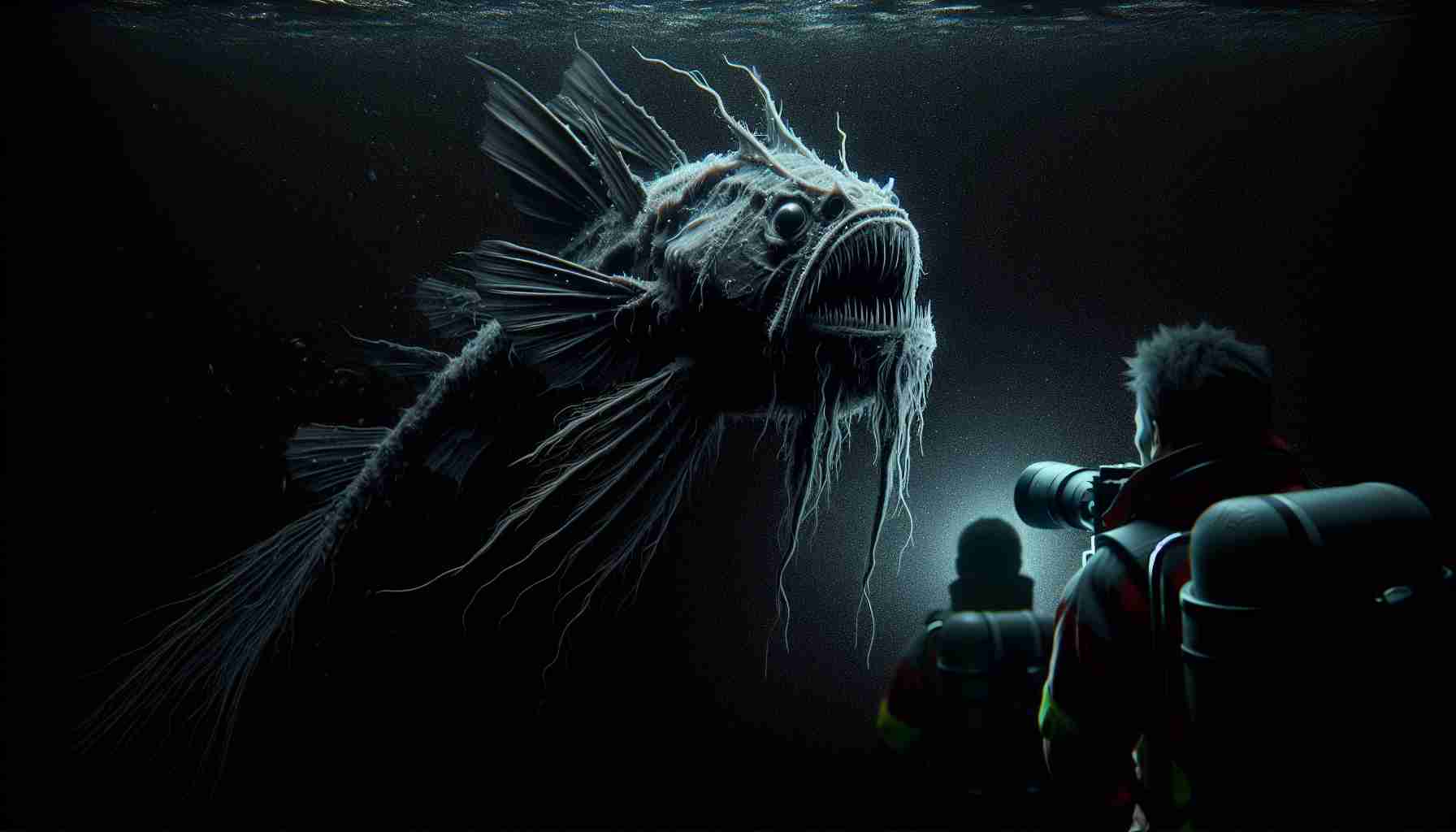- The rare “black devil” anglerfish, Melanocetus johnsonii, was unexpectedly sighted near Tenerife, marking a potential first daylight sighting.
- This deep-sea creature typically resides at depths of 200 to 2,000 meters, using bioluminescence to attract prey.
- Marine organization Condrik Tenerife shared this remarkable encounter with images by photographer David Jara Boguñá.
- The fish’s appearance may have been due to an upwelling or escaping a predator; it was in a weakened state upon surfacing.
- Marine biologist Laia Valor observed the event, witnessing the fish’s brief struggle before its death.
- The specimen was preserved at the Museum of Nature and Archaeology in Tenerife, sparking further interest in deep-sea mysteries.
Beneath the glittering waters near Tenerife, a mesmerizing creature of the deep emerged, casting a mysterious silhouette against the sunlight. Known as the “black devil” and formally tagged as Melanocetus johnsonii, this elusive deep-sea marvel appeared unexpectedly near the shores of Guía de Isora, sparking awe and intrigue.
Condrik Tenerife, an organization dedicated to marine life research, unveiled this extraordinary encounter on Instagram with vivid imagery captured by marine photographer David Jara Boguñá. The grotesque beauty of the “black devil,” usually ensconced in the ocean’s abyssal depths, graced the surface, potentially marking the first-ever daylight sighting of a living specimen.
This deep-sea phantom, native to the murky realms between 200 and 2,000 meters, typically lurks unseen, wielding its bioluminescent lure to ensnare prey. Its wicked teeth and lethal allure make it a formidable inhabitant of the underworld. Yet here it was, far from home, in a weakened state, perhaps lifted by an upwelling or driven by a desperate urge to escape an unseen predator.
Marine biologist Laia Valor witnessed this rare spectacle while returning to port. She described a fleeting black form that defied expectations, drawing her curiosity amid the familiar sea panorama. Alas, unable to endure the surface’s harsh reality, the enigmatic fish succumbed soon after its rise, later finding a resting place at the Museum of Nature and Archaeology in Tenerife.
Though its sudden appearance remains cloaked in mystery, its brief sojourn above reveals the profound secrets still hidden beneath the ocean’s waves. Such encounters not only thrill but remind us of the delicate balances poised in the silent world below. Who knows what other mysteries wait in the gloom, awaiting discovery?
The Mesmerizing Mystery of the ‘Black Devil’ Fish: What Lies Beneath?
Unraveling the Secrets of the Black Devil Fish
The sighting of the “black devil” fish, scientifically known as Melanocetus johnsonii, near Tenerife has captured the imaginations of marine enthusiasts and scientists alike. Often residing in the deep, dark ocean at depths of 200 to 2,000 meters, this extraordinary creature of the abyss is typically enveloped in perpetual darkness, making its appearance near the surface a spectacular event.
Features, Specs & Pricing
Physical Characteristics:
The black devil fish is known for its unique and intimidating features, such as its bioluminescent lure, which is used to attract prey in the dark ocean depths. This lure, situated at the end of a stalk on its head, can emit light, helping it to catch unsuspecting prey. The fish’s razor-sharp teeth and ferocious appearance are adapted for its stealthy predatory lifestyle.
Size:
The species typically measures around 8 inches in length, though females are much larger than their male counterparts, a common feature in many deep-sea fish.
Habitat:
While predominantly dwelling in the abyssal zones of the ocean, sightings near the surface remain rare. Factors such as upwellings, changes in sea currents, or attempts to escape predators can contribute to these unusual appearances.
Real-World Use Cases & Importance
Ecological Role:
Black devil fish are crucial for maintaining the deep-sea ecosystem’s balance. As apex predators in their environment, they help control the population of smaller fish and invertebrates.
Scientific Research:
Studying such rare creatures can offer insights into deep-sea ecosystems and adaptations required to survive in extreme conditions. Their bioluminescence has inspired research into new technologies in lighting and imaging.
Market Forecasts & Industry Trends
Interest in deep-sea biology and the potential applications of bioluminescence is growing. Industries ranging from healthcare to technology are exploring bioluminescent applications for innovative products and solutions, such as medical imaging technologies and sustainable lighting.
Pros & Cons Overview
Pros:
– Biodiversity Insight: The appearance of the black devil represents an opportunity to better understand the rich biodiversity of deep-sea environments.
– Bioluminescence Research: Its unique ability to produce light is an area of interest for biotech research.
Cons:
– Threatened Habitats: Human activities, such as deep-sea fishing and mining, threaten these creatures’ habitats.
– Limited Survivability: The fish’s inability to survive long outside its natural pressure-intense environment highlights the challenges of deep-sea research.
Tutorials & Compatibility
Studying Deep-Sea Creatures:
For those interested in marine biology, pursuing studies in oceanography or marine sciences can offer practical knowledge in deep-sea exploration and conservation.
Security & Sustainability
Conservation Efforts:
Organizations like MarineBio.org are instrumental in conservation efforts focusing on protecting deep-sea creatures and their habitats from environmental threats.
Controversies & Limitations
The enigmatic lives of deep-sea creatures like the black devil shed light on the limitations of current marine exploration technology. While deep-sea research is expensive and technically challenging, advances in robotic technology and submersible vehicles are helping overcome some of these barriers.
Actionable Recommendations
1. Support Marine Conservation: Contributing to organizations working towards preserving oceanic biodiversity can make a significant difference.
2. Stay Informed: Following marine research organizations on social media platforms can keep you updated on new discoveries and related ecological news.
3. Promote Sustainability: Opting for sustainable seafood options and reducing plastic use can help mitigate the negative impacts on marine life.
The appearance of the black devil fish is not just a spectacle but a reminder of the myriad mysteries the ocean holds. Each encounter offers lessons in diversity, adaptation, and the urgent need for conservation efforts.
